Dry Eye Disease Market Size
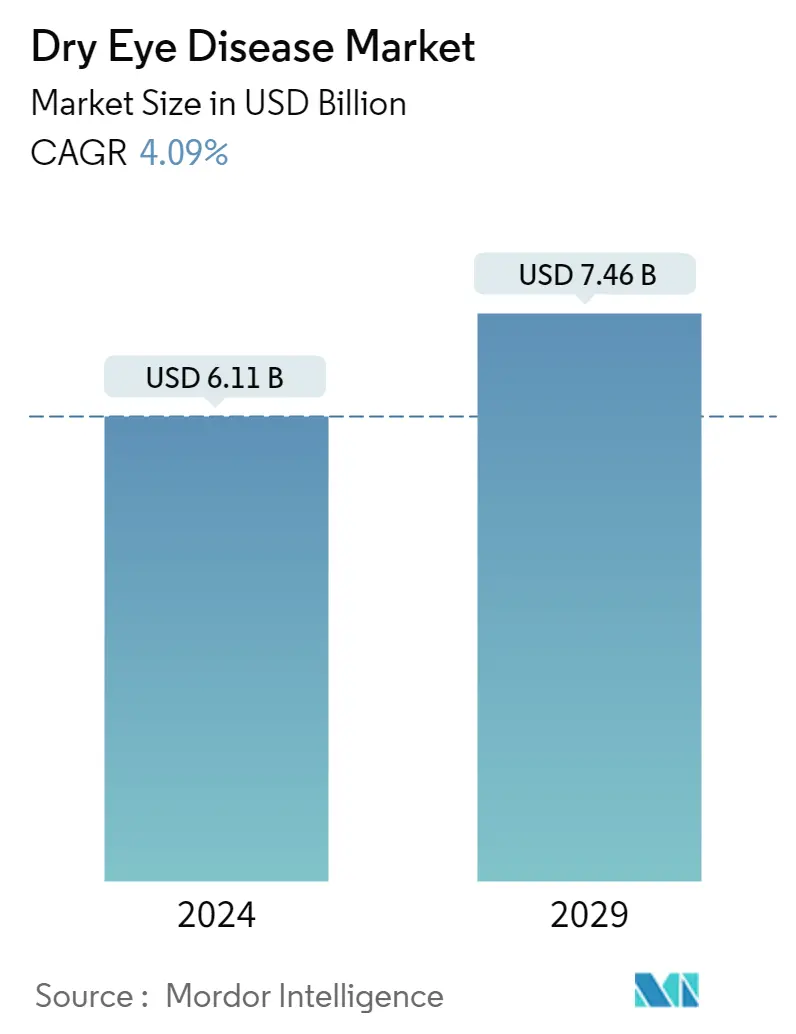
| Study Period | 2021 - 2029 |
| Market Size (2024) | USD 6.11 Billion |
| Market Size (2029) | USD 7.46 Billion |
| CAGR (2024 - 2029) | 4.09 % |
| Fastest Growing Market | Asia-Pacific |
| Largest Market | North America |
Major Players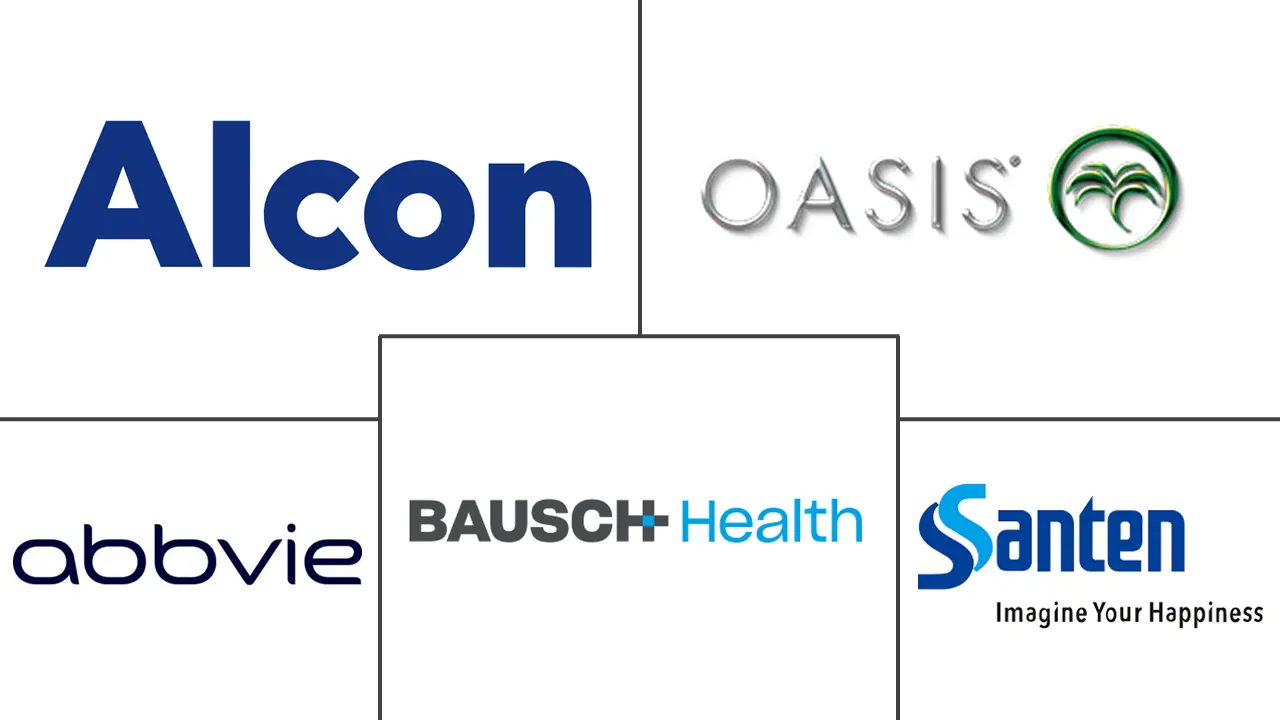
*Disclaimer: Major Players sorted in no particular order |
Dry Eye Disease Market Analysis
The Dry Eye Disease Market size is estimated at USD 6.11 billion in 2024, and is expected to reach USD 7.46 billion by 2029, growing at a CAGR of 4.09% during the forecast period (2024-2029).
The impact of COVID-19 on the dry eye market was adverse in the initial phases owing to the cancellations in elective procedures including diagnosis and eye treatments along with supply chain disruptions of medications worldwide. During the lockdown, people's screen time (irrespective of their age) increased significantly, which had a severe impact, and an increase in ophthalmic disorders was observed. For instance, a research study published in December 2021 stated that both dry eye disease (DED) patients and healthy participants up to the age of 60 experienced worsening dry-eye symptoms during the COVID-19 lockout due to increased visual display terminal (VDT) period. The study also reported that younger persons had more severe dry-eye problems than older respondents, particularly during the lockdown. Therefore, the market gained traction as the restrictions were lifted. Since the pandemic led to an increase in dry eye disease cases globally. Hence, it is expected to propel the market growth during the forecast period.
Several factors, such as aging, decreasing supportive hormones, systemic inflammatory diseases, ocular surface diseases, or surgeries that affect the cholinergic nerves, which stimulate tear secretion, may be associated with the rising prevalence of dry eye-related diseases. For instance, an article published in Frontiers in Medicine Journal stated that among people who require eye care, DED has become the fifth most prevalent ocular condition in women and ninth most prevalent in men in the United States in 2021. Additionally, an article published in the Journal of the British College of Ophthalmic Opticians stated that the global prevalence of dry eye disease was estimated at 11.59% in 2021. Thus, the burden of DED is anticipated to drive the studied market growth in the country.
Furthermore, a research study published in BMC in Opthalmology Journal in May 2021, conducted a survey by 452 participants in Dubai, out of which 63.7% were females. The prevalence of dry eyes in Dubai was estimated to be 62.6% in the surveyed population, with 42% having severely dry eyes. A significant percentage of the global population suffers from dry eye disease. The disease is particularly more common among women than in men. This factor is responsible for propelling the market growth in the analysis period.
The strategic initiatives adopted by the key market players such as product launches, approvals, partnerships is also driving growth. For instance, in November 2021, I-MED Pharma USA launched I-DROP MGD, preservative-free, viscoadaptive eye drop containing a lipid designed to enhance and stabilize all three layers of the tear film to treat dry eye. Such developments are estimated to augment the market growth during the forecast period.
However, the high cost of specialty dry eye products with complex reimbursement scenarios and the availability of alternative therapies are likely to impede the market's growth over the forecast period.
Dry Eye Disease Market Trends
This section covers the major market trends shaping the Dry Eye Disease Market according to our research experts:
The Corticosteroid Drugs Segment is Expected to Hold a Major Market Share Over the Forecast Period
The Corticosteroids drug segment is expected to hold a significant market share owing to its huge demand for treating dry eye diseases, advantages, and rising product launches and approvals.
According to a research study published in Clinical Opthalmology Journal in February 2021, the mean age of the patients surveyed was 57.8 years, and the tear MMP-9 positivity was 73.0%. The patients were kept on topical corticosteroids treatment for one month which showed significant improvement of symptoms and signs in the patients, an improvement of up to 90.6%. This indicates the high prevalence of dry eye disease in the elderly population. Given the advantages of corticosteroids like anti-inflammatory benefits and providing symptom relief with short-term use, the segment is estimated to propel during the forecast period.
It has also been found that the elderly population is expected to grow in the coming years. This population group is more prone to eye-related disorders, which will ultimately drive the market in the future. Rising product approvals and new product launches are other factors anticipated to propel the demand for corticosteroids. For instance, in February 2021, the US FDA approved an abbreviated new drug application (ANDA) submitted by Akorn Operating Company LLC for loteprednol etabonate ophthalmic gel 0.5%, which is indicated for the treatment of post-operative inflammation and pain following ocular surgery.
Overall, this segment has the greatest share of anti-inflammatory medications in the market studied, and it is predicted to exhibit stable growth during the forecast period.
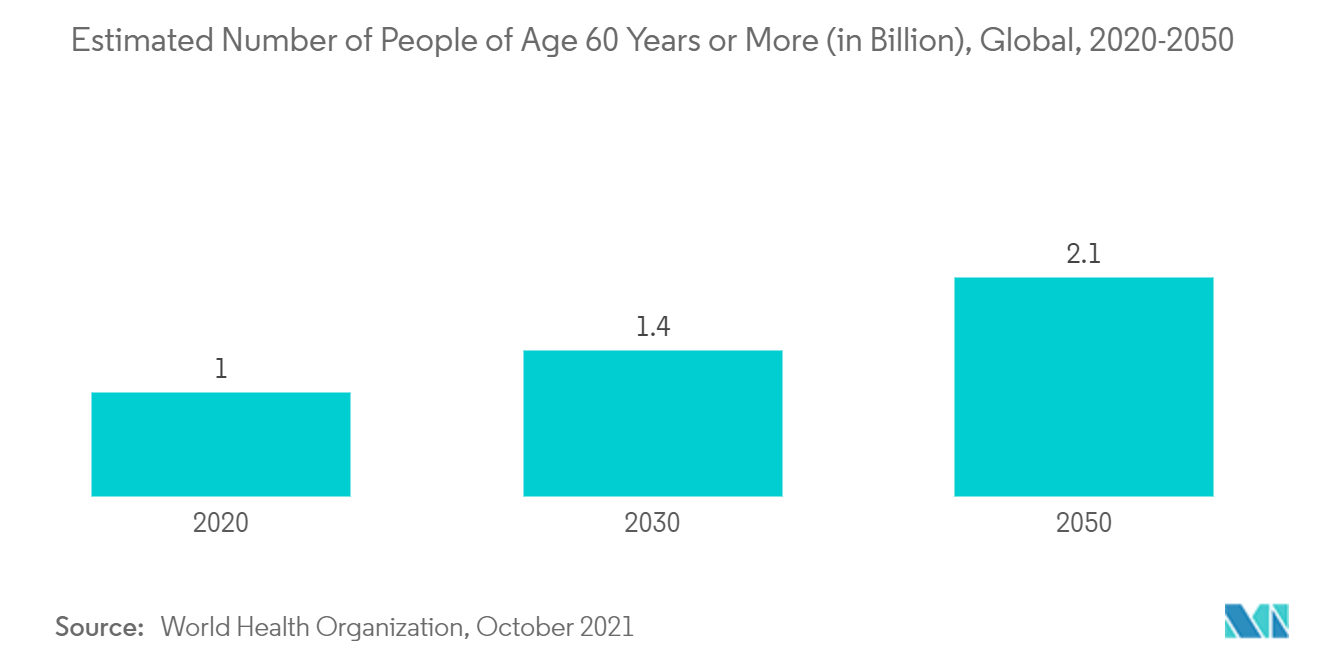
North America is Expected to Hold a Significant Share in the Market Over the Forecast Period
North America is expected to hold a major share of the dry eye disease market owing to the high prevalence of dry eye diseases and the easy availability of solutions in the region.
There are people of various ages found living in this multi-screen world. Computer or digital screen use may cause less blinking, which may contribute to symptoms of dry eye disease (DED), thereby, increasing the demand for better and more effective therapeutics against DED which is expected to fuel growth in the studied market in the North American region. For instance, an article published in Cureus Journal in July 2022 stated that the prevalence of DED has been estimated at 21% in Canada. Women who used eye cosmetics were substantially more likely to have DED than the general population, which suggests that using eye cosmetics is one of the risk factors for developing DED. The high prevalence of the disease is estimated to boost market growth in the region during the forecast period.
Additionally, drug launches are one of the key factors boosting the market's growth in the region. For instance, in January 2021, Kala Pharmaceuticals Inc. launched EYSUVIS (loteprednol etabonate ophthalmic suspension) 0.25% for the short-term (up to two weeks) treatment of the signs and symptoms of dry eye disease. EYSUVIS is now available in national and regional United States pharmaceutical distribution centers. Patients with a prescription can access EYSUVIS through their local retail pharmacies or home delivery.
Furthermore, in January 2022, Sun Pharma Canada Inc, a subsidiary of the Mumbai-based company Sun Pharmaceutical Industries Limited launched Cequa (cyclosporine ophthalmic solution 0.09 percent w/v), a calcineurin inhibitor immunomodulator. All these novel product launches may give the country a cutting edge in the market. Thus, due to the above-mentioned factors, the North American market for dye eye disease is expected to occupy a major share in the studied market and grow over the forecast period.
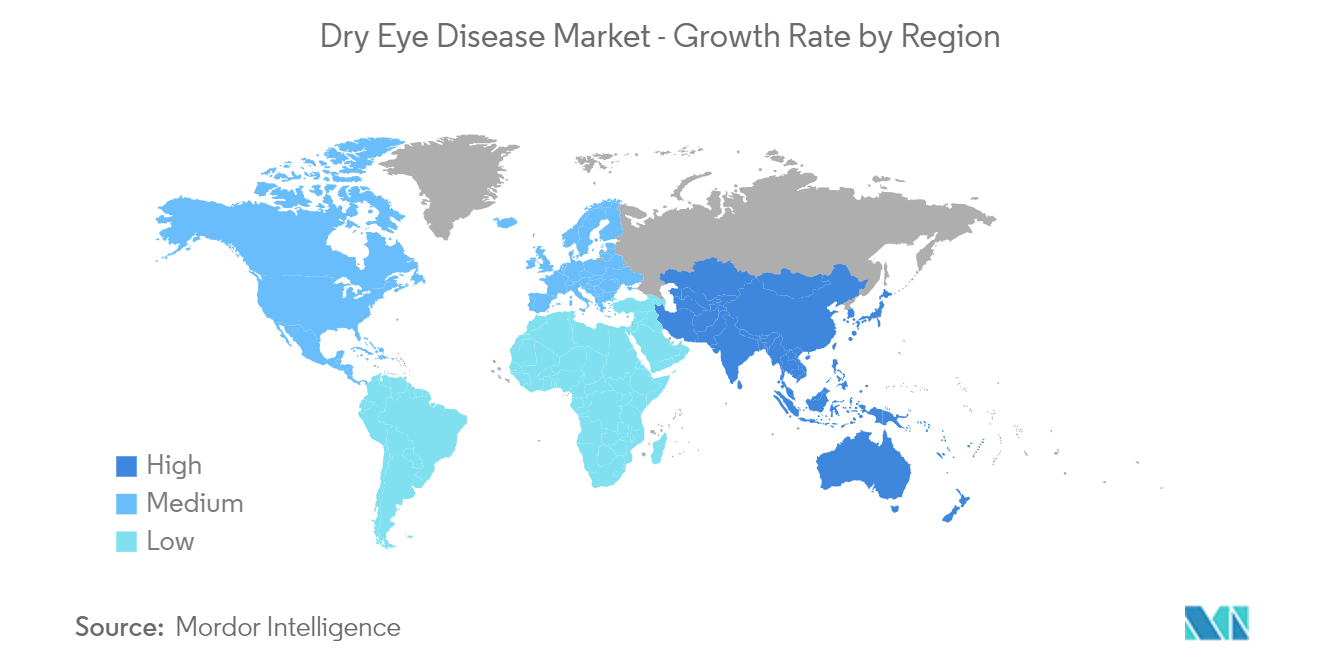
Dry Eye Disease Industry Overview
The dry eye disease market is fragmented in nature due to the presence of many companies operating globally as well as regionally. The competitive landscape includes an analysis of a few international and local companies that hold market shares and are well known. Some major players are AbbVie Inc. (Allergan PLC), AFT Pharmaceuticals, Akorn, Alcon Inc., Bausch Health Companies Inc., Horus Pharma, Johnson & Johnson, Mitotech, Novaliq GmbH, OASIS Medical, Otsuka Pharmaceutical Co. Ltd, Prestige Consumer Healthcare, Santen Pharmaceutical Co. Ltd, Sentiss Pharma Pvt. Ltd, Sun Pharmaceutical Industries Ltd, and VISUfarma.
Dry Eye Disease Market Leaders
-
Santen Pharmaceutical Co. Ltd
-
OASIS Medical
-
Alcon Inc.
-
Bausch Health Companies Inc.
-
AbbVie Inc. (Allergan PLC)
*Disclaimer: Major Players sorted in no particular order
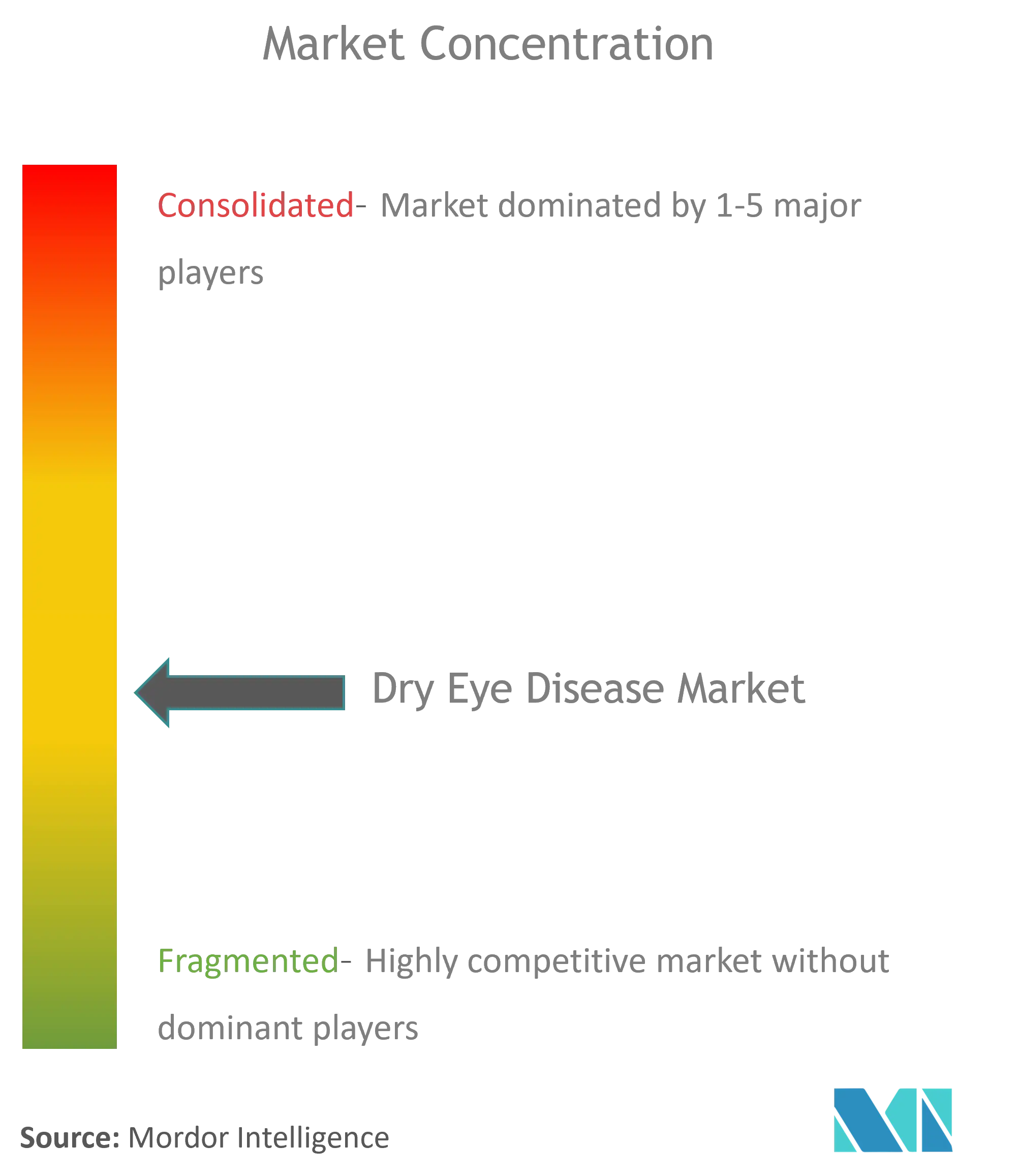
Dry Eye Disease Market News
- October 2022 : Aldeyra Therapeutics, Inc. completed the phase 3 clinical trial of 0.25% reproxalap ophthalmic solution, an investigational new drug candidate, for treating allergic conjunctivitis. The company presented the clinical data from the trial at the American Academy of Optometry 2022 Annual Meeting.
- January 2022 : NovaBay Pharmaceuticals launched Avenova lubricating eye drops to treat dry eye symptoms.
Dry Eye Disease Market Report - Table of Contents
1. INTRODUCTION
- 1.1 Study Assumptions and Market Definition
- 1.2 Scope of the Study
2. RESEARCH METHODOLOGY
3. EXECUTIVE SUMMARY
4. MARKET DYNAMICS
- 4.1 Market Overview
-
4.2 Market Drivers
- 4.2.1 Rising Burden of Dry Eye Disease
- 4.2.2 Technological Advancements and Emergence of Novel Diagnostic Tools
-
4.3 Market Restraints
- 4.3.1 High Cost of Specialty Dry Eye Products with Complex Reimbursement Scenario
- 4.3.2 Availability of Alternative Therapies
-
4.4 Porter's Five Forces Analysis
- 4.4.1 Threat of New Entrants
- 4.4.2 Bargaining Power of Buyers/Consumers
- 4.4.3 Bargaining Power of Suppliers
- 4.4.4 Threat of Substitute Products
- 4.4.5 Intensity of Competitive Rivalry
5. MARKET SEGMENTATION (Market Size by Value - USD million)
-
5.1 By Product
- 5.1.1 Artificial Tears
- 5.1.2 Anti-inflammatory Drugs
- 5.1.2.1 Cyclosporine
- 5.1.2.2 Corticosteroid
- 5.1.2.3 Other Anti-inflammatory Drugs
- 5.1.3 Punctal Plugs
- 5.1.4 Secretagogues
- 5.1.5 Other Products
-
5.2 By Distribution Channel
- 5.2.1 Hospital Pharmacies
- 5.2.2 Independent Pharmacies and Drug Stores
- 5.2.3 Online Pharmacies
-
5.3 Geography
- 5.3.1 North America
- 5.3.1.1 United States
- 5.3.1.2 Canada
- 5.3.1.3 Mexico
- 5.3.2 Europe
- 5.3.2.1 Germany
- 5.3.2.2 United Kingdom
- 5.3.2.3 France
- 5.3.2.4 Italy
- 5.3.2.5 Spain
- 5.3.2.6 Rest of Europe
- 5.3.3 Asia-Pacific
- 5.3.3.1 China
- 5.3.3.2 Japan
- 5.3.3.3 India
- 5.3.3.4 Australia
- 5.3.3.5 South Korea
- 5.3.3.6 Rest of Asia-Pacific
- 5.3.4 Middle East and Africa
- 5.3.4.1 GCC
- 5.3.4.2 South Africa
- 5.3.4.3 Rest of Middle East and Africa
- 5.3.5 South America
- 5.3.5.1 Brazil
- 5.3.5.2 Argentina
- 5.3.5.3 Rest of South America
6. COMPETITIVE LANDSCAPE
-
6.1 Company Profiles
- 6.1.1 AbbVie Inc. (Allergan PLC)
- 6.1.2 AFT Pharmaceuticals
- 6.1.3 Akorn
- 6.1.4 Alcon Inc.
- 6.1.5 Bausch Health Companies Inc.
- 6.1.6 Horus Pharma
- 6.1.7 Johnson & Johnson
- 6.1.8 Mitotech
- 6.1.9 Novaliq GmbH
- 6.1.10 OASIS Medical
- 6.1.11 Otsuka Pharmaceutical Co. Ltd
- 6.1.12 Prestige Consumer Healthcare
- 6.1.13 Santen Pharmaceutical Co. Ltd
- 6.1.14 Sentiss Pharma Pvt. Ltd
- 6.1.15 Sun Pharmaceutical Industries Ltd
- 6.1.16 VISUfarma
- *List Not Exhaustive
7. MARKET OPPORTUNITIES AND FUTURE TRENDS
** Subject To AvailablityDry Eye Disease Industry Segmentation
As per the scope of the report, dry eye disease refers to the disturbance of the lacrimal functional unit, which comprises the lacrimal glands, ocular surface (cornea, conjunctiva, and meibomian glands), and lids, along with the sensory and motor nerves that connect them. The Dry Eye Disease Market is Segmented by Product, Artificial Tears, Anti-inflammatory Drugs (Cyclosporine, Corticosteroid, and Other Anti-inflammatory Drugs), Punctal Plugs, Secretagogues, and Other Products, Distribution Channels (Hospital Pharmacies, Independent Pharmacies, and Drug Stores, and Online Pharmacies), and Geography (North America, Europe, Asia-Pacific, Middle-East and Africa, and South America). There are various ocular manifestations that use several dry eye treatment products. The market report also covers the estimated market sizes and trends for 17 countries across major regions globally. The report offers the value in USD million for the above segments.
| By Product | Artificial Tears | |
| Anti-inflammatory Drugs | Cyclosporine | |
| Corticosteroid | ||
| Other Anti-inflammatory Drugs | ||
| Punctal Plugs | ||
| Secretagogues | ||
| Other Products | ||
| By Distribution Channel | Hospital Pharmacies | |
| Independent Pharmacies and Drug Stores | ||
| Online Pharmacies | ||
| Geography | North America | United States |
| Canada | ||
| Mexico | ||
| Geography | Europe | Germany |
| United Kingdom | ||
| France | ||
| Italy | ||
| Spain | ||
| Rest of Europe | ||
| Geography | Asia-Pacific | China |
| Japan | ||
| India | ||
| Australia | ||
| South Korea | ||
| Rest of Asia-Pacific | ||
| Geography | Middle East and Africa | GCC |
| South Africa | ||
| Rest of Middle East and Africa | ||
| Geography | South America | Brazil |
| Argentina | ||
| Rest of South America |
Dry Eye Disease Market Research FAQs
How big is the Dry Eye Disease Market?
The Dry Eye Disease Market size is expected to reach USD 6.11 billion in 2024 and grow at a CAGR of 4.09% to reach USD 7.46 billion by 2029.
What is the current Dry Eye Disease Market size?
In 2024, the Dry Eye Disease Market size is expected to reach USD 6.11 billion.
Who are the key players in Dry Eye Disease Market?
Santen Pharmaceutical Co. Ltd, OASIS Medical, Alcon Inc., Bausch Health Companies Inc. and AbbVie Inc. (Allergan PLC) are the major companies operating in the Dry Eye Disease Market.
Which is the fastest growing region in Dry Eye Disease Market?
Asia-Pacific is estimated to grow at the highest CAGR over the forecast period (2024-2029).
Which region has the biggest share in Dry Eye Disease Market?
In 2024, the North America accounts for the largest market share in Dry Eye Disease Market.
What years does this Dry Eye Disease Market cover, and what was the market size in 2023?
In 2023, the Dry Eye Disease Market size was estimated at USD 5.87 billion. The report covers the Dry Eye Disease Market historical market size for years: 2021, 2022 and 2023. The report also forecasts the Dry Eye Disease Market size for years: 2024, 2025, 2026, 2027, 2028 and 2029.
What are the major factors driving the Dry Eye Disease Market?
The major factors driving the Dry Eye Disease Market are a) Growing demand for convenient and effective treatment options b) Educational campaigns and products aimed at preventing dry eye before symptoms arise can expand the market
Dry Eye Disease Industry Report
The Global Intellectual Property Management Software Market Report is segmented by deployment, solution, type, end-user industry, and geography, providing a comprehensive market analysis. The market is driven by the increasing volume of patents, trademarks, and copyrights, necessitating efficient management solutions. Cloud deployments and the IT & telecom sector are pivotal in market expansion. The rising demand for streamlined administrative processes and strict enforcement of intellectual property laws are key growth drivers. However, the market faces challenges such as the complexity of global intellectual property laws and high initial costs.
The Asia Pacific region, led by technological innovations and a high number of filings, is a major contributor to the market's expansion. Market trends indicate a shift towards collaborations and strategic partnerships to enhance software functionality and user experience, addressing the diverse legal needs across different regions. The intellectual property market size is set to expand, with software solutions playing a crucial role in managing and protecting intellectual property assets efficiently.
For detailed statistics on the intellectual property management software market share, size, and revenue growth rate, consult the Mordor Intelligence™ Industry Reports. Get a comprehensive market forecast outlook and historical overview by downloading a free report PDF sample from their website. This industry analysis highlights the importance of market trends, industry overview, and market research in understanding the market value and market segmentation. The market report provides insights into market growth, market data, and market review, helping identify market leaders and industry statistics. The industry reports and research companies offer an in-depth industry outlook and market predictions essential for understanding industry size and industry sales.



